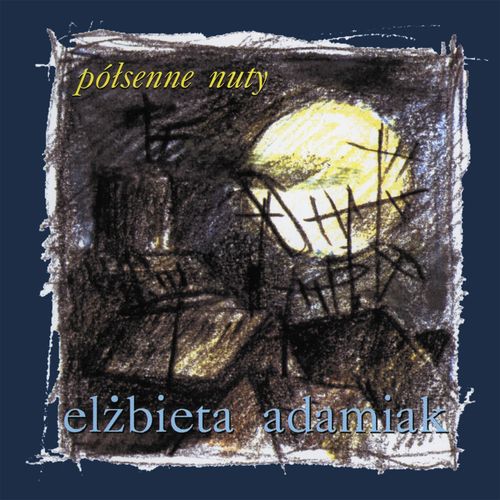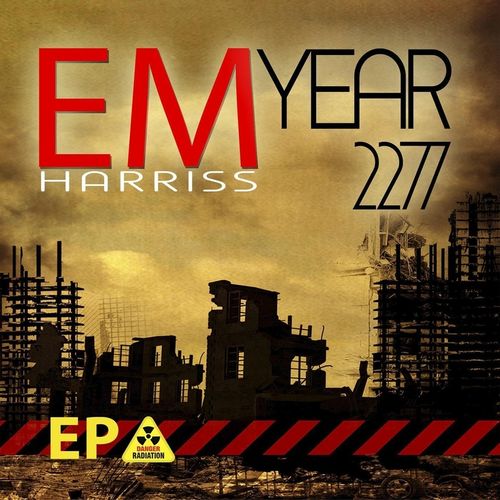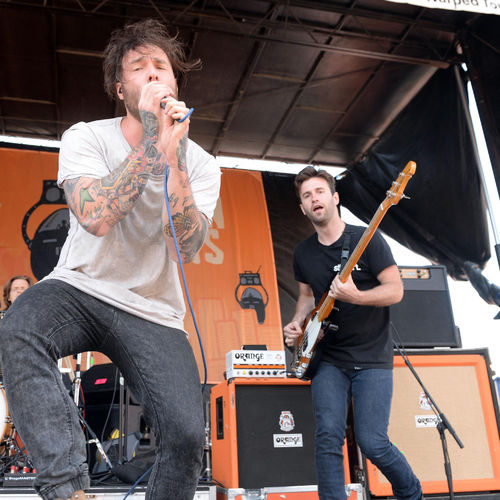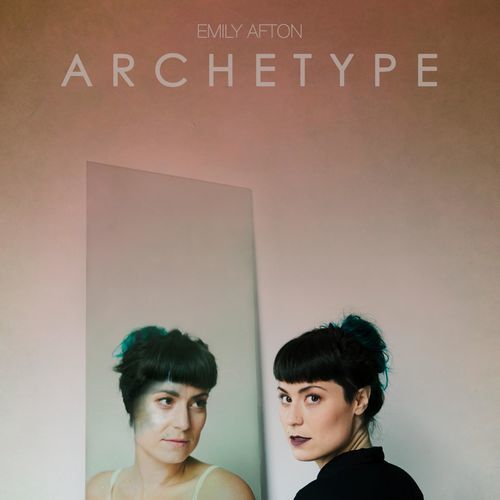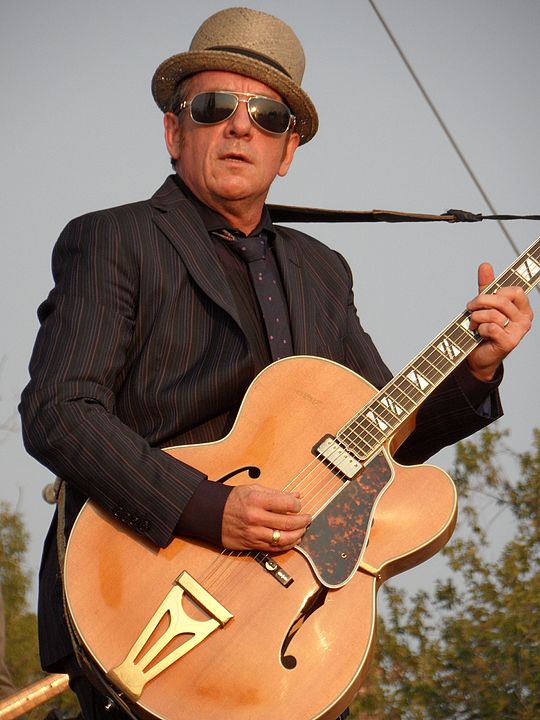
Biography:
Elvis Costello (born Declan Patrick MacManus on 25 August 1954) is an internationally known English singer-songwriter. Gaining prominence as an early participant in London's pub rock scene in the mid-70s, he burst into fame with his critically acclaimed 1977 debut 'My Aim Is True', still one of the most successful debuts of all time. He soon did much work in the genres of punk rock, power pop, and New Wave after he formed Elvis Costello & The Attractions.
Read more on Last.fm

Other songs:
- Alison
- Alsion
- Beautiful
- Cheap Rewards
- Everyday I Write The Book
- Mystery Dance
- Oliver's Army
- Pump It Up
- She
- This Is Hell
- Watching The Detectives
- Whats So Funny
- 45
- A Condemned Man
- Accidents Will Happen
- After The Fall
- Alibi Factory
- All Grown Up
- All The Rage
- All These Strangers
- All This Useless Beauty
- Almost Blue
- American Without Tears
- B Movie
- Baby Plays Around
- Back On My Feet
- Beyond Belief
- Big Boys
- Big Sisters Clothes
- Blame It On Cain
- Blue Chair
- Brilliant Mistake
- Brown To Blue
- Bullets For The New Born King
- Burnt Sugar Is So Bitter
- Busy Bodies
- Charm School
- Cheap Reward
- Church Underground
- Clowntime Is Over
- Clubland
- Coal
- Complicated Shadows
- Couldnt Call It Unexpected No4
- Crawling To The Usa
- Crimes Of Paris
- Deep Dark Truthful Mirror
- Deportee
- Different Finger
- Dont Let Me Be Misunderstood
- Dr Watson I Presume
- Eisenhower Blues
- Favourite Hour
- Fish N Chip Paper
- Five Small Words
- Forgive Her Anything
- From A Whisper To A Scream
- Georgie And Her Rival
- Girls Talk
- Glitter Gulch
- Gloomy Sunday
- God Give Me Strength
- Gods Comic
- Good Year For The Roses
- Goon Squad
- Green Shirt
- Hand In Hand
- Harpies Bizarre
- Heart Shaped Bruise
- Heres Red Shoes
- High Fidelity
- Home Is Anywhere
- Honey Are You Straight Or Are You Blind
- Hoover Factory
- How To Be Dumb
- Human Hands
- Human Touch
- I Cant Stand Up For Falling Down
- I Dont Want To Go Home
- I Dont Want To Go To Chelsea
- I Dreamed Of My Old Lover
- I Hope Youre Happy Now
- I Just Dont Know What To Do With Myself
- I Lost You
- I Still Have That Other Girl
- I Want To Vanish
- I Want You
- If I Could Put Them All Together
- Ill Wear It Proudly
- Im In The Mood Again
- Im Not Angry
- Im Your Toy
- Imagination
- In Another Room
- Inch By Inch
- Indoor Fireworks
- Jack Of All Parades
- Jimmie Standing In The Rain
- Joe Porterhouse
- Jump Up
- Kid About It
- Kinder Murder
- Less Than Zero
- Let Him Dangle
- Lip Service
- Lipstick Vogue
- Little Palaces
- Little Savage
- Little Triggers
- Living In Paradise
- Londons Brilliant Parade
- Love Went Mad
- Loveable
- Lovers Walk
- Luxembourg
- Man Out Of Time
- Miracle Man
- Monkey To Man
- My Babys Gone
- My Funny Valentine
- My Mood Swings
- My Youngest Son Came Home Today
- New Amsterdam
- New Amsterdam Youve Got To Hide Your Love Away
- New Lace Sleeves
- No Action
- No Dancing
- Olivers Army
- One Bell Ringing
- Our Little Angel
- Pads Paws And Claws
- Party Girl
- Pay It Back
- Peace In Our Time
- Pidgin English
- Poison Moon
- Poisoned Rose
- Pony St
- Poor Fractured Atlas
- Poor Napoleon
- Pouring Water On A Drowning Man
- Pretty Words
- Psycho
- Put Your Big Toe In The Milk Of Human Kindness
- Radio Radio
- Radio Sweetheart
- Riot Act
- Rocking Horse Road
- Running Out Of Angels
- Satellite
- Shabby Doll
- Shamed Into Love
- She Loves The Jerk
- Shipbuilding
- Sleep Of The Just
- Sleepless Nights
- Sneaky Feelings
- So Like Candy
- Song With Rose
- St Stephens Day Murders
- Starting To Come To Me
- Still
- Still Too Soon To Know
- Strict Time
- Success
- Suffering Face
- Suit Of Lights
- Sulfur To Sugarcane
- Sulky Girl
- Sweet Dreams
- Taking My Life In Your Hands
- Tear Off Your Own Head Its A Doll Revolution
- Thats Not The Part Of Him Youre Leaving
- The Angels Want To Wear My Red Shoes
- The Beat
- The Big Light
- The Element Within Her
- The Ghost Of Tom Joad Do Re Mi
- The Greatest Love
- The Imposter
- The Long Honeymoon
- The Loved Ones
- The Only Flame In Town
- The Other End
- The Other Side Of Summer
- The Scarlet Tide
- The Spell That You Cast
- The Sweetest Punch
- The World And His Wife
- This House Is Empty Now
- This Years Girl
- Toledo
- Tommys Coming Home
- Too Far Gone
- Tramp The Dirt Down
- Tripwire
- Two Little Hitlers
- Uncomplicated
- Under Lime
- Unwanted Number
- Veronica
- Voice In The Dark
- Waiting For The End Of The World
- Watch Your Step
- Wave A White Flag
- Whats So Funny Bout Peace Love And Understanding
- When I Was Cruel
- When It Signs
- When It Sings
- Who Do You Think You Are
- Withered And Died
- Worthless Thing
- You Belong To Me
- You Little Fool
- You Shouldnt Look At Me That Way
- You Tripped At Every Step
- Youll Never Be A Man
Four years of hard work!This month of May we celebrated four years on the air. We continue working on the dissemination of this wonderful instrument, thank you for participating in our story!
#----------------------------------PLEASE NOTE---------------------------------#
#This file is the author's own work and represents their interpretation of the #
#song. You may only use this file for private study, scholarship, or research. #
#------------------------------------------------------------------------------##
From: [email protected] (Mark J. Schnitzius)
I Hope You're Happy Now
from Blood and Chocolate
tabbed by [email protected]
This is a guitar-based transcription, though some notes played
by other instruments may be included so that the lone guitarist
can more fully realize the tune as it exists on Blood & Chocolate.
Those lone guitarists with dexterity trouble can skip those notes
and still "put over" the song in question, but it won't sound as cool.
Lower case letters indicate that the preceding chord should be played
with the lower case note in the bass (e.g. A g f# = you play an
A chord, then you play an A chord with a G in the bass, then an A chord with
an F# in the bass)
Tricky chords are pictured below the transcription.
Correspond to the list, or [email protected].
N.C.
he's a fine figure of a man and handsome
A / Asus (alternate between the two)
too. with his eyes upon the secret places
A7 D/ Dsus (alternate between the two)
he'd like to undo.
Bm B flat A B flat
still he knows who and where and how---------------->
Bm D E
and I hope you're happy now
A / Asus
N.C.
he's got all the things you need and some that you would
A/ Asus
never. but you make him sound like frozen food his
A7 D / Dsus
love will last for- ever
Bm B flat A
B flat
still he knows what you want and what you don't allow------------->
Bm D E
and I hope you're happy now
A / Asus <A C# E>riff
F#m Emaj6 A A7
I hope that you're happy now the way you're supposed to be
DaddE,(F# in bass) Esus
and I know that this will hurt you
A <E D C# B>riff
more than it hurts me
A/ Asus
N.C.
he's acting inncocent and proud still you know what he's
A/ Asus
after. like a matador with his pork sword while
A7 D / Dsus
we all die of laughter
Bm B flat A
B flat
in his turquoise pa- jamas and his motorcycle hat------------>I
Bm D DaddE,(F# in bass)
hope you're happy now because you'll soon put
<E D C# B>riff
pay to that
F#m Emaj6 A
I knew then what I know now
F#m Emaj6 D DaddE,(F# in bass)
I never loved you anyhow
Bm D E
and I hope you're happy now
A / Asus A7 <A C# E>riff
F#m Emaj6 A
I knew then what I know now
F#m Emaj6 D DaddE,(F# in bass)
I never loved you anyhow
Bm D E
and I hope you're happy now
Bm D E
and I hope you're happy now
Bm D E
and I hope you're happy now
A G F# A
I hope you're happy now
--fade--
------------------------------------------------------------------------------------
Emaj6 DaddE, (f# in bass)
o o x o o
____________ ____________
6 5 4 3 2 1 6 5 4 3 2 1
1I X 1I
2I X X X 2I X X
3I 3I X
4I 4I
5I 5I
6I 6I
Esus
o o o
____________
6 5 4 3 2 1
1I
2I X X X
3I
4I
5I
6I
>From [email protected] Tue Apr 26 21:31:06 1994
Return-Path:
<[email protected]>
To: [email protected]
Date: Mon, 25 Apr 94 22:10:27 EDT
Subject: **I HOPE YOU'RE HAPPY NOW**
Status: R
I HOPE YOU'RE HAPPY NOW
This is a guitar-based transcription, though some notes played
by other instruments may be included so that the lone guitarist
can more fully realize the tune as it exists on Blood & Chocolate.
Those lone guitarists with dexterity trouble can skip those notes
and still "put over" the song in question, but it won't sound as cool.
Lower case letters indicate that the preceding chord should be played
with the lower case note in the bass (e.g. A g f# = you play an
A chord, then you play an A chord with a G in the bass, then an A chord with
an F# in the bass)
Tricky chords are pictured below the transcription.
Correspond to the list, or [email protected].
-------------------------------------------------------------------------------
I HOPE YOU'RE HAPPY NOW
N.C.
he's a fine figure of a man and handsome
A / Asus (alternate between the two)
too. with his eyes upon the secret places
A7 D/ Dsus (alternate between the two)
he'd like to undo.
Bm B flat A B flat
still he knows who and where and how---------------->
Bm D E
and I hope you're happy now
A / Asus
N.C.
he's got all the things you need and some that you would
A/ Asus
never. but you make him sound like frozen food his
A7 D / Dsus
love will last for- ever
Bm B flat A
B flat
still he knows what you want and what you don't allow------------->
Bm D E
and I hope you're happy now
A / Asus <A C# E>riff
F#m Emaj6 A A7
I hope that you're happy now the way you're supposed to be
DaddE,(F# in bass) Esus
and I know that this will hurt you
A <E D C# B>riff
more than it hurts me
A/ Asus
N.C.
he's acting inncocent and proud still you know what he's
A/ Asus
after. like a matador with his pork sword while
A7 D / Dsus
we all die of laughter
Bm B flat A
B flat
in his turquoise pa- jamas and his motorcycle hat------------>I
Bm D DaddE,(F# in bass)
hope you're happy now because you'll soon put
<E D C# B>riff
pay to that
F#m Emaj6 A
I knew then what I know now
F#m Emaj6 D DaddE,(F# in bass)
I never loved you anyhow
Bm D E
and I hope you're happy now
A / Asus A7 <A C# E>riff
F#m Emaj6 A
I knew then what I know now
F#m Emaj6 D DaddE,(F# in bass)
I never loved you anyhow
Bm D E
and I hope you're happy now
Bm D E
and I hope you're happy now
Bm D E
and I hope you're happy now
A G F# A
I hope you're happy now
--fade--
------------------------------------------------------------------------------------
Emaj6 DaddE, (f# in bass)
o o x o o
____________ ____________
6 5 4 3 2 1 6 5 4 3 2 1
1I X 1I
2I X X X 2I X X
3I 3I X
4I 4I
5I 5I
6I 6I
Esus
o o o
____________
6 5 4 3 2 1
1I
2I X X X
3I
4I
5I
6I
#This file is the author's own work and represents their interpretation of the #
#song. You may only use this file for private study, scholarship, or research. #
#------------------------------------------------------------------------------##
From: [email protected] (Mark J. Schnitzius)
I Hope You're Happy Now
from Blood and Chocolate
tabbed by [email protected]
This is a guitar-based transcription, though some notes played
by other instruments may be included so that the lone guitarist
can more fully realize the tune as it exists on Blood & Chocolate.
Those lone guitarists with dexterity trouble can skip those notes
and still "put over" the song in question, but it won't sound as cool.
Lower case letters indicate that the preceding chord should be played
with the lower case note in the bass (e.g. A g f# = you play an
A chord, then you play an A chord with a G in the bass, then an A chord with
an F# in the bass)
Tricky chords are pictured below the transcription.
Correspond to the list, or [email protected].
N.C.
he's a fine figure of a man and handsome
A / Asus (alternate between the two)
too. with his eyes upon the secret places
A7 D/ Dsus (alternate between the two)
he'd like to undo.
Bm B flat A B flat
still he knows who and where and how---------------->
Bm D E
and I hope you're happy now
A / Asus
N.C.
he's got all the things you need and some that you would
A/ Asus
never. but you make him sound like frozen food his
A7 D / Dsus
love will last for- ever
Bm B flat A
B flat
still he knows what you want and what you don't allow------------->
Bm D E
and I hope you're happy now
A / Asus <A C# E>riff
F#m Emaj6 A A7
I hope that you're happy now the way you're supposed to be
DaddE,(F# in bass) Esus
and I know that this will hurt you
A <E D C# B>riff
more than it hurts me
A/ Asus
N.C.
he's acting inncocent and proud still you know what he's
A/ Asus
after. like a matador with his pork sword while
A7 D / Dsus
we all die of laughter
Bm B flat A
B flat
in his turquoise pa- jamas and his motorcycle hat------------>I
Bm D DaddE,(F# in bass)
hope you're happy now because you'll soon put
<E D C# B>riff
pay to that
F#m Emaj6 A
I knew then what I know now
F#m Emaj6 D DaddE,(F# in bass)
I never loved you anyhow
Bm D E
and I hope you're happy now
A / Asus A7 <A C# E>riff
F#m Emaj6 A
I knew then what I know now
F#m Emaj6 D DaddE,(F# in bass)
I never loved you anyhow
Bm D E
and I hope you're happy now
Bm D E
and I hope you're happy now
Bm D E
and I hope you're happy now
A G F# A
I hope you're happy now
--fade--
------------------------------------------------------------------------------------
Emaj6 DaddE, (f# in bass)
o o x o o
____________ ____________
6 5 4 3 2 1 6 5 4 3 2 1
1I X 1I
2I X X X 2I X X
3I 3I X
4I 4I
5I 5I
6I 6I
Esus
o o o
____________
6 5 4 3 2 1
1I
2I X X X
3I
4I
5I
6I
>From [email protected] Tue Apr 26 21:31:06 1994
Return-Path:
<[email protected]>
To: [email protected]
Date: Mon, 25 Apr 94 22:10:27 EDT
Subject: **I HOPE YOU'RE HAPPY NOW**
Status: R
I HOPE YOU'RE HAPPY NOW
This is a guitar-based transcription, though some notes played
by other instruments may be included so that the lone guitarist
can more fully realize the tune as it exists on Blood & Chocolate.
Those lone guitarists with dexterity trouble can skip those notes
and still "put over" the song in question, but it won't sound as cool.
Lower case letters indicate that the preceding chord should be played
with the lower case note in the bass (e.g. A g f# = you play an
A chord, then you play an A chord with a G in the bass, then an A chord with
an F# in the bass)
Tricky chords are pictured below the transcription.
Correspond to the list, or [email protected].
-------------------------------------------------------------------------------
I HOPE YOU'RE HAPPY NOW
N.C.
he's a fine figure of a man and handsome
A / Asus (alternate between the two)
too. with his eyes upon the secret places
A7 D/ Dsus (alternate between the two)
he'd like to undo.
Bm B flat A B flat
still he knows who and where and how---------------->
Bm D E
and I hope you're happy now
A / Asus
N.C.
he's got all the things you need and some that you would
A/ Asus
never. but you make him sound like frozen food his
A7 D / Dsus
love will last for- ever
Bm B flat A
B flat
still he knows what you want and what you don't allow------------->
Bm D E
and I hope you're happy now
A / Asus <A C# E>riff
F#m Emaj6 A A7
I hope that you're happy now the way you're supposed to be
DaddE,(F# in bass) Esus
and I know that this will hurt you
A <E D C# B>riff
more than it hurts me
A/ Asus
N.C.
he's acting inncocent and proud still you know what he's
A/ Asus
after. like a matador with his pork sword while
A7 D / Dsus
we all die of laughter
Bm B flat A
B flat
in his turquoise pa- jamas and his motorcycle hat------------>I
Bm D DaddE,(F# in bass)
hope you're happy now because you'll soon put
<E D C# B>riff
pay to that
F#m Emaj6 A
I knew then what I know now
F#m Emaj6 D DaddE,(F# in bass)
I never loved you anyhow
Bm D E
and I hope you're happy now
A / Asus A7 <A C# E>riff
F#m Emaj6 A
I knew then what I know now
F#m Emaj6 D DaddE,(F# in bass)
I never loved you anyhow
Bm D E
and I hope you're happy now
Bm D E
and I hope you're happy now
Bm D E
and I hope you're happy now
A G F# A
I hope you're happy now
--fade--
------------------------------------------------------------------------------------
Emaj6 DaddE, (f# in bass)
o o x o o
____________ ____________
6 5 4 3 2 1 6 5 4 3 2 1
1I X 1I
2I X X X 2I X X
3I 3I X
4I 4I
5I 5I
6I 6I
Esus
o o o
____________
6 5 4 3 2 1
1I
2I X X X
3I
4I
5I
6I


